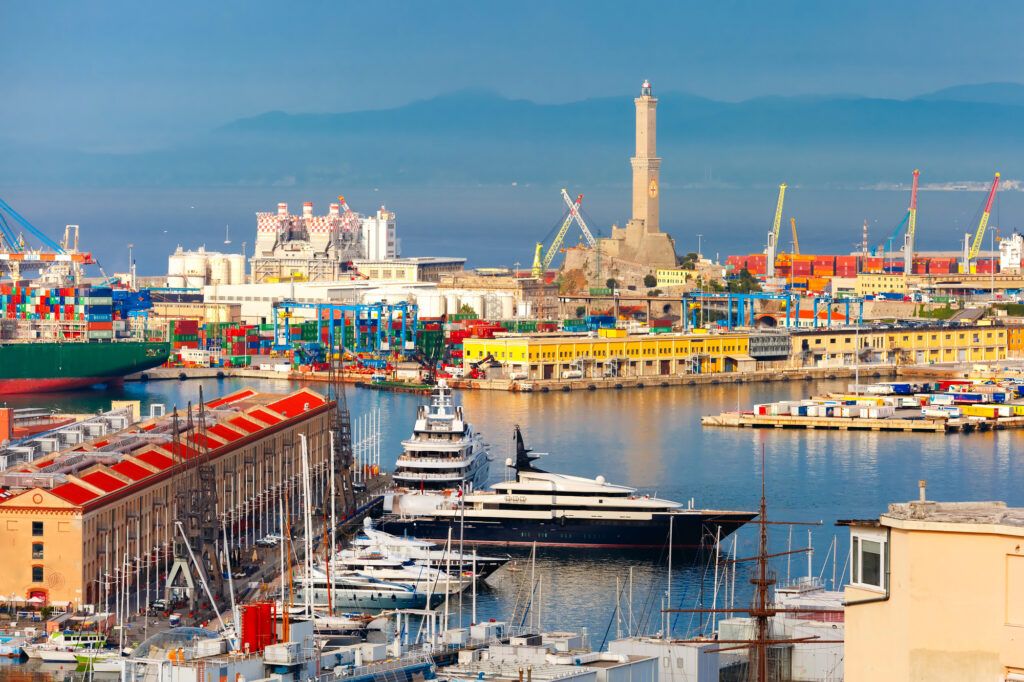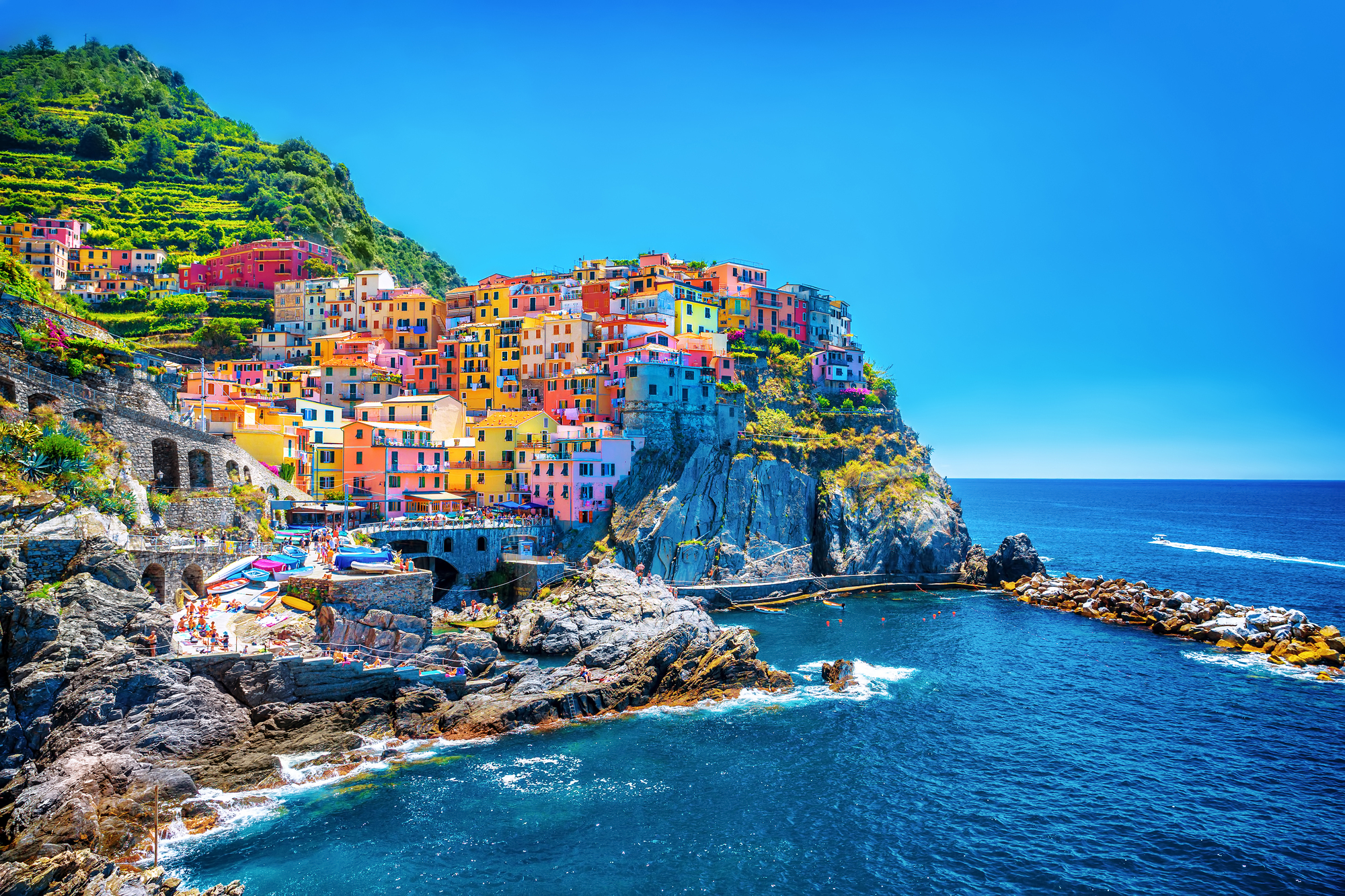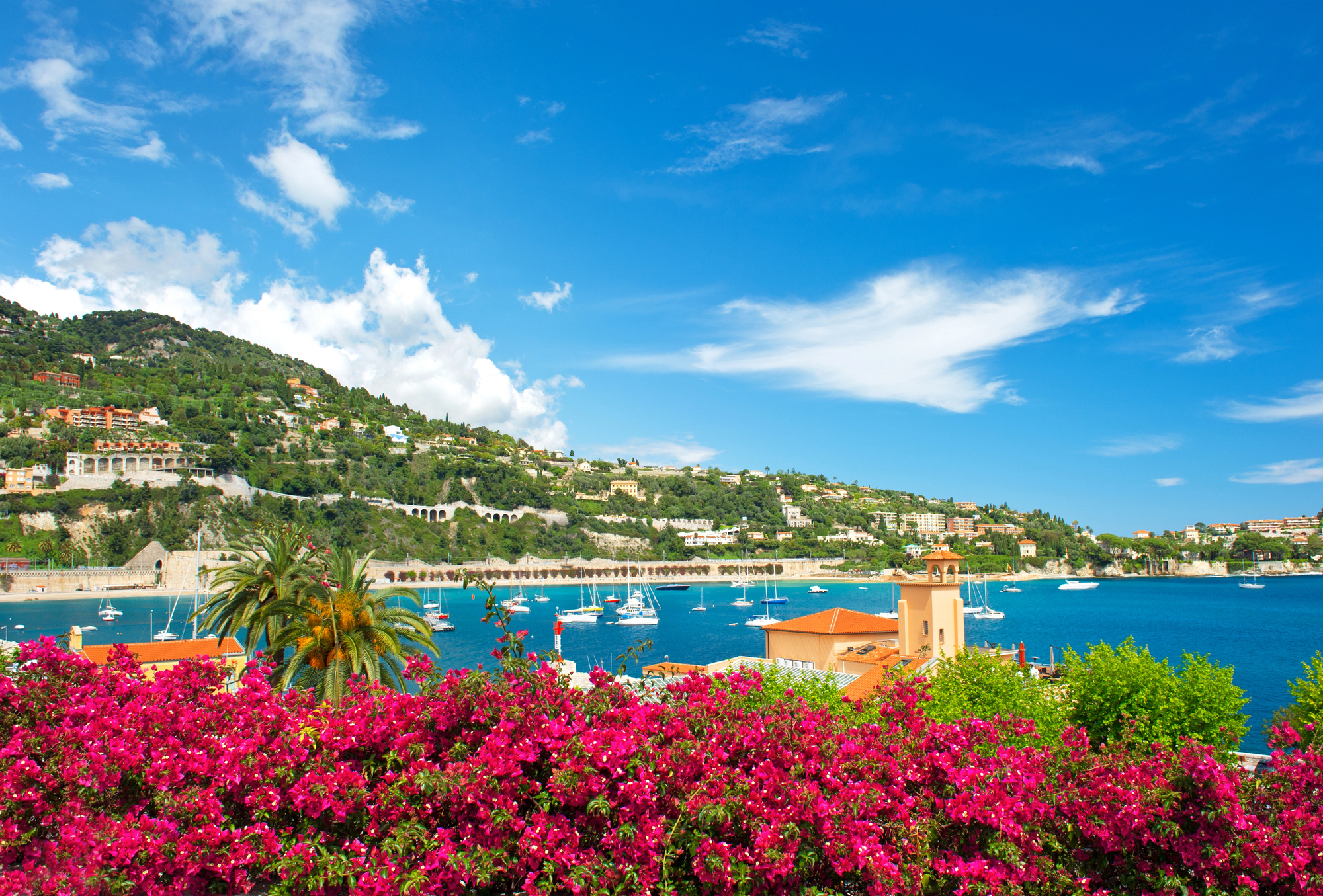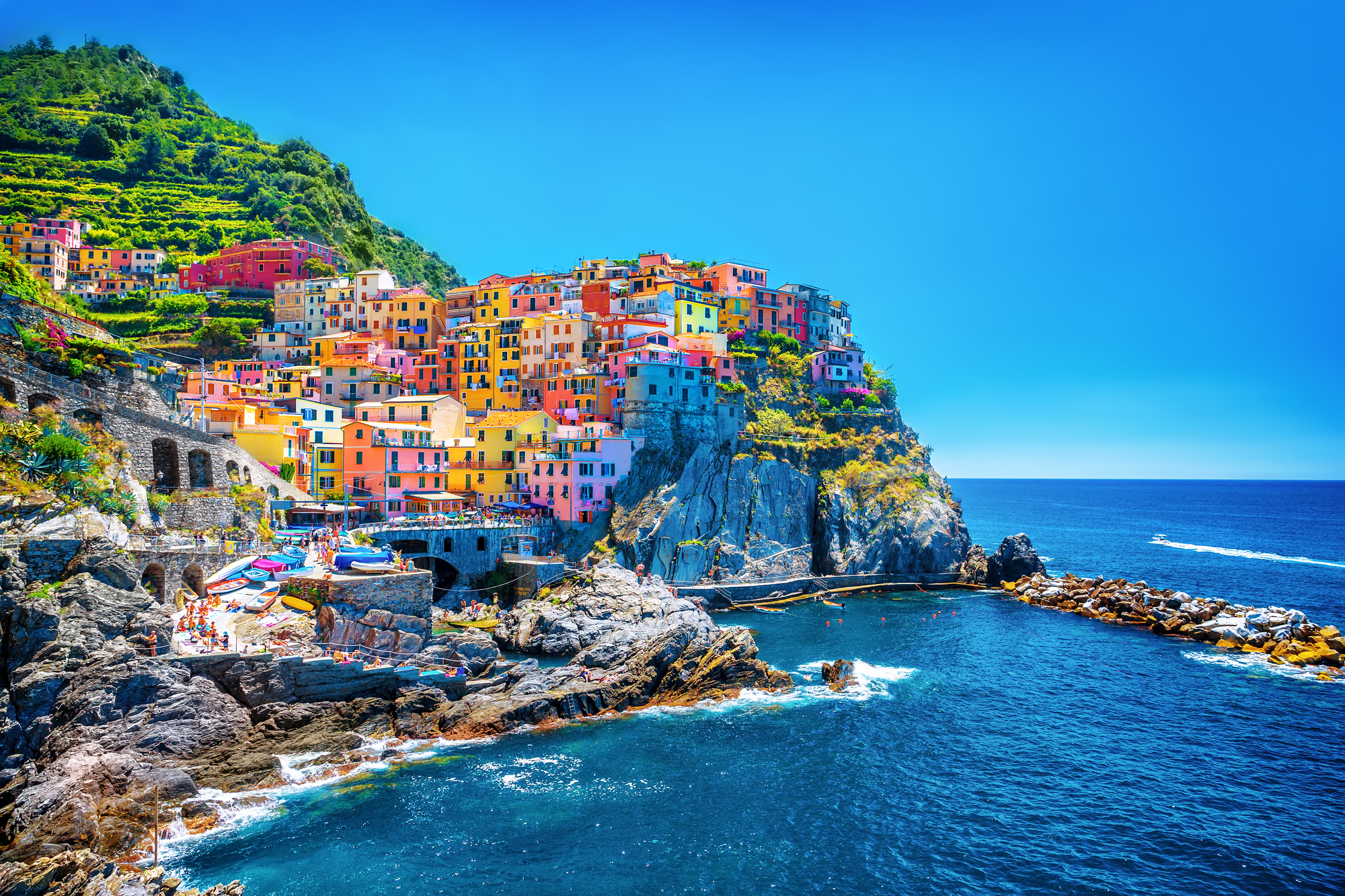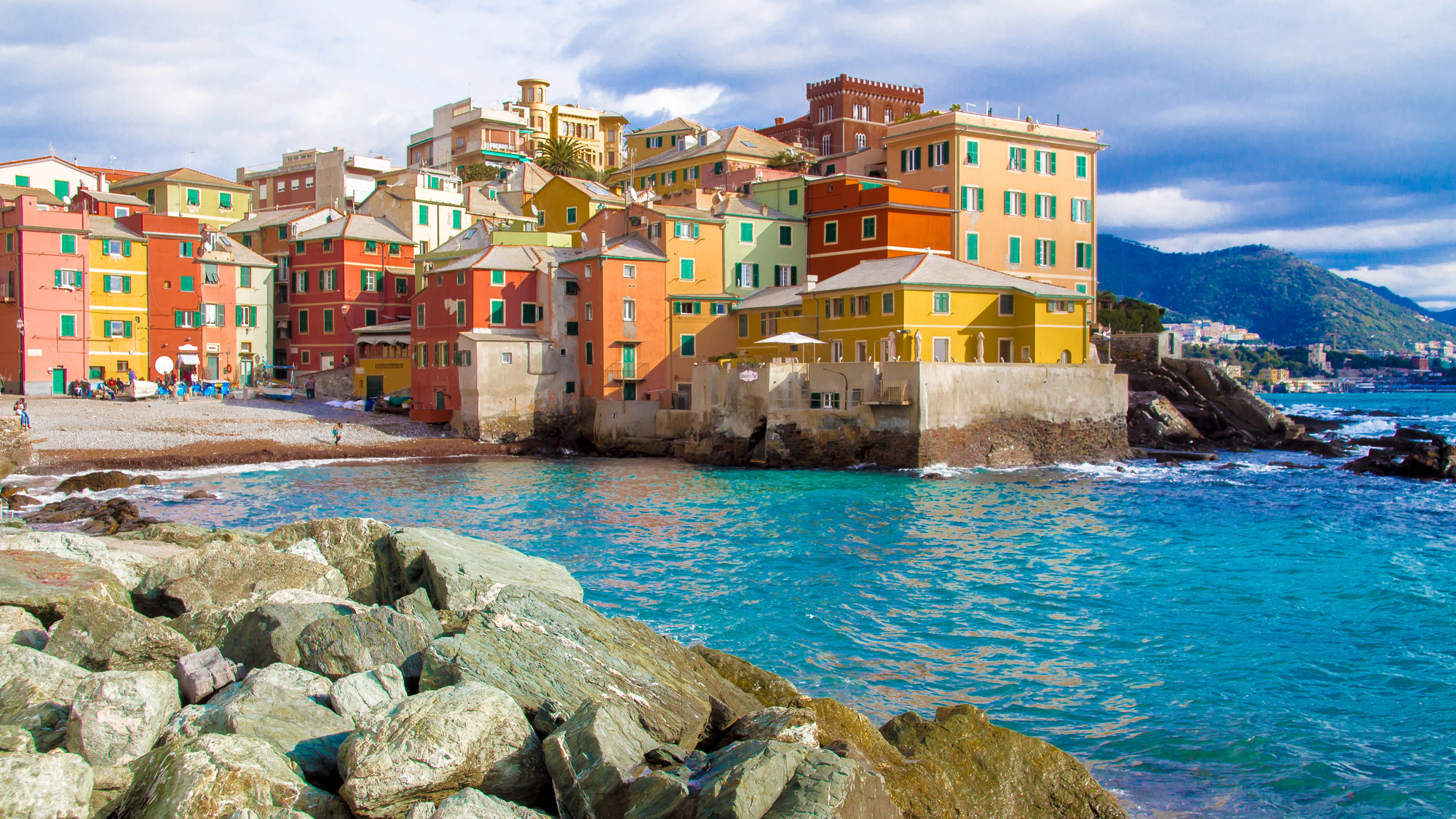Genoa‘s cruise port greets you at Italy’s largest seaport—one of the Mediterranean’s best-kept secrets. The port sits just steps away from the historic center, so cruise passengers can dive right into centuries-old streets, striking architecture, and genuine Italian culture, all without the crowds you’ll find in more famous places.
Exploring Genoa from the cruise terminal gives you a fantastic mix of sights, from the colorful fishing village of Boccadasse to the grand palaces along Strada Nuova. You’re free to get lost in the winding “caruggi” (those narrow medieval alleys), check out Christopher Columbus’s old haunts at Porta Soprana, or just chill by the fountain in Piazza De Ferrari.
Get a discount of 15% to 70% on accommodation in Genoa! Look for deals here:
Genoa Hotels, Apartments, B&Bs
This city invented pesto, so food lovers are in for a treat. Lots of people sign up for a pesto-making class or grab slices of authentic Genoese focaccia from the local bakeries. The cruise terminal connects to great public transit, so you can see a lot in one day without shelling out for pricey shore excursions.
Overview of Genoa Cruise Port
Genoa Cruise Port stands out as a major Mediterranean cruise hub, with two terminals that see thousands of passengers every year. The port mixes old-school maritime vibes with modern cruise comforts.
Location and Accessibility
You’ll find Genoa Cruise Port smack in the heart of Genoa (Genova), Italy, right on the Ligurian Sea. The two main terminals—Ponte dei Mille and Ponte Andrea Doria—sit close to the city center, so it’s easy for cruise guests to explore Genoa.
A quick 15-20 minute walk gets you from the port to the historic city center and the famous Porto Antico (Old Port). Not up for walking? Buses stop right near the terminals, and the Genova Piazza Principe train station is just a 10-minute stroll away.
If you’re starting or ending your cruise in Genoa, Cristoforo Colombo Airport is about 7 km from the terminals. Taxis and shuttles run between the airport and port all day.
History and Significance
Genoa’s port has shaped Mediterranean trade since Roman times. Back in the Middle Ages, Genoa became one of the four Maritime Republics and turned into a naval powerhouse.
Modern cruise facilities grew out of this long maritime tradition. The Stazione Marittima (Maritime Station) building, built in the early 1900s, was later renovated for today’s cruise passengers. Now, it serves as the main terminal.
Genoa Port has fueled Italy’s economy for centuries. These days, it’s Italy’s busiest port by cargo volume and the home base for MSC Cruises. Many cruise lines start and end their journeys here.
The port’s location makes it a great jumping-off point for the Italian Riviera, Cinque Terre, Milan, and other northern Italian spots.
Types of Cruise Ships Docking
Genoa sees all kinds of cruise ships, from massive mainstream vessels to smaller, upscale liners. MSC Cruises uses Genoa as a home port for many Mediterranean trips, and their biggest ships, like the MSC Meraviglia and MSC Seaside class, often dock here.
Costa Cruises also stops in Genoa a lot. You’ll see ships from Royal Caribbean, Norwegian Cruise Line, and Princess Cruises, too.
The port can handle anything—from cozy luxury ships with just a few hundred guests to mega-ships carrying over 5,000 people. Ponte dei Mille usually takes the big ships, while Ponte Andrea Doria handles smaller or overflow vessels, especially when it gets busy.
Cruise season peaks from April through October, with July and August being the craziest months. You might spot several ships in port at once during this time.
Understanding the Cruise Ship Terminal
Genoa’s two main cruise terminals greet visitors with different facilities and processes.
Facilities and Services
The main terminal, Stazione Marittima, offers all the essential services cruise travelers need. Inside, English-speaking staff at information desks hand out city maps and transportation tips.
You can stash your bags for a small fee if you’d rather explore Genoa without dragging luggage around. The terminal has clean restrooms, ATMs, and a café for a quick espresso or snack before you head out.
Wi-Fi is free throughout the terminal, but honestly, the speed can be hit or miss. A few souvenir shops sell postcards, local goodies, and travel basics.
Taxis usually wait right outside. If you need a wheelchair or special help, just let the staff know in advance—they’ll sort it out.
Arrivals and Departures Process
When your ship docks at Ponte dei Mille or Ponte Andrea Doria, you’ll walk through a covered walkway to the main building. Disembarkation usually starts around 8:00 AM.
You’ll need to show your cruise card to leave the secure area. On busy days with multiple ships, lines at security can get a bit long, but they typically move pretty fast.
For departures, check-in counters open 4-5 hours before sailing. The terminal uses a numbered boarding system to keep things organized. Suite guests and loyalty members get priority boarding.
Security checks include the usual X-ray and metal detectors. The process is generally smooth, but arriving 2-3 hours ahead is smart, especially from May to September.
Transportation Options
Getting to and around Genoa from the cruise port is pretty straightforward, and you have plenty of budget-friendly options. The city has good connections that help you make the most of your time.
Getting To and From the Port
The Genoa cruise terminal (Ponte dei Mille) links up with the city by several transportation choices. There’s a free metro service right across from the port that takes you downtown in just four stops—a great way to save some cash compared to cruise shuttles.
If you’re flying into Genoa Airport, a direct bus brings you to the port for about €5. You can buy tickets with the AMT app or onboard. The ride takes roughly 30 minutes, depending on traffic.
Private transfers in business cars cost about $70-74 and get you there in 20 minutes or so. Taxis are easy to find, but they’re pricier than public transit.
Train Connections and Services
Genoa’s train network makes reaching other Italian cities easy. The main station, Genoa Piazza Principe, is about a 15-minute walk from the cruise port or just one metro stop away.
Regular trains connect Genoa to:
- Milan (about 1.5 hours)
- Turin (roughly 1.75 hours)
- The Cinque Terre (1-1.5 hours)
- Portofino area (via Santa Margherita Ligure station)
To reach Portofino, take a train to Santa Margherita Ligure, then hop on a ferry or bus for the last stretch. Doing it yourself saves a lot compared to cruise excursions.
Trains run frequently, but always check schedules in advance—especially on Sundays, when service might be lighter.
Public Transportation in Genoa
Genoa’s historic center is compact and walkable, but the public transport system helps you reach further spots. AMT runs buses, the metro, and funiculars all over the city.
The metro is easy—just 8 stops—so you won’t get lost. Single tickets cost about €1.50 and cover 100 minutes on any AMT service. Day passes are a good deal if you’re riding a lot.
Buses fill in the gaps and can take you outside the center. The old-school funiculars climb up to panoramic viewpoints and the city’s hilltop neighborhoods.
The AMT app is handy for route planning and buying tickets. Most buses and metro lines accept contactless payment, so you don’t have to worry about cash.
Popular Excursions and Sightseeing from Genoa
Genoa’s location makes it a great base for exploring both the city itself and the beautiful Ligurian coast. Whether you’re into history or just want to soak up the scenery, you’ll find plenty to do.
Exploring Genoa: Top Landmarks and Attractions
Kick off your Genoa adventure at Piazza De Ferrari, the city’s main square and a lively spot with a gorgeous fountain. It’s where old and new Genoa meet.
The ancient Porta Soprana gates and the nearby Christopher Columbus House give you a glimpse into the city’s seafaring past. Columbus was born here, and Genoa takes pride in that.
Boccadasse, a little fishing village that’s technically part of Genoa, is a must-see. Its pastel houses and tiny beach feel like a world away, even though it’s just a short bus ride from the center.
If you love food, try a pesto-making class. Genoa is the birthplace of pesto, and learning from a local chef is a fun, hands-on way to experience the city.
Day Trips to Portofino and the Ligurian Coast
Portofino—a stunning fishing village turned luxury hotspot—sits 35 km from Genoa. With its pastel buildings, yachts, and fancy shops, it’s a highlight of the Riviera di Levante.
Santa Margherita Ligure, close to Portofino, has beautiful beaches, elegant villas, and a more laid-back vibe with fewer tourists. It’s a great spot for a relaxed day trip.
Camogli is another gem along the coast, known for its tall, colorful houses and a pretty harbor. The seafood here is top-notch, and the town feels peaceful.
You can visit these towns by train or ferry, or join a guided tour from the cruise port if you want someone else to handle the details. Most tours hit two or three towns in one day.
Cinque Terre Excursion Options
The Cinque Terre is made up of five villages perched on cliffs along the coast—Monterosso, Vernazza, Corniglia, Manarola, and Riomaggiore—each with its own unique charm.
From Genoa, full-day trips to these UNESCO-listed villages usually last 8-10 hours. You can go with a private guide or join a group tour if you want to save money.
Most tours include transport, a guide, and time to wander a few villages. Some also offer short hikes on the scenic coastal trails or boat rides for those classic sea views.
Getting from Genoa to Cinque Terre takes about 1.5-2 hours each way. If you’re feeling adventurous, you can do it on your own by train, but organized tours take the hassle out of planning and usually share some cool insights along the way.
Extended Excursions to Milan, Corsica, Sardinia, Sicily, Barcelona, and Rome
Milan is only 1.5 hours away by train, so a quick day trip to see the Gothic cathedral or do some shopping is totally doable. Fashion fans especially love this option.
Some longer cruises offer overnight trips to farther spots. Corsica, with its wild beaches and mountains, is a ferry ride away—expect 5-7 hours on the water.
Sardinia and Sicily each show off a different side of Italian island life. These are more for multi-day trips, usually as part of a longer cruise itinerary.
Occasionally, cruises include international excursions to Barcelona or Rome. These involve flights or overnight trains and give you a couple of days to explore before heading back to your ship.
Must-See Sights in Genoa
Genoa’s maritime history and architecture give you plenty of eye-catching landmarks to check out. The city’s old-world atmosphere shines through its historic buildings, lively piazzas, and cultural highlights.
Aquarium of Genoa
The Aquarium of Genoa is easily one of Europe’s largest aquariums and definitely a must-see in the city. You’ll find it in the Old Port area, where it’s packed with over 12,000 animals from 600 different species.
The main exhibition winds through nearly 2.5 miles and 70 displays, each one recreating a different marine environment. As you wander, you’ll spot sharks, dolphins, seals, and all sorts of vibrant tropical fish in habitats that feel surprisingly natural.
The Mediterranean Sea exhibits really shine here, with local marine life shown off in impressive detail. Interactive displays make it easier to get what’s at stake with ocean conservation and biodiversity—pretty eye-opening, honestly.
Give yourself at least 2-3 hours to really enjoy the place. It gets crowded, especially in peak season, so if you want a more relaxed visit, it’s best to show up early.
Piazza De Ferrari
Piazza De Ferrari is the main square and, honestly, the lively heart of Genoa. Right in the center, a stunning bronze fountain catches your eye, surrounded by grand old buildings.
This square links the old town with the modern city center. All around, you’ll see the Ducal Palace, Carlo Felice Opera House, and the Palace of the Doges—each showing off a mix of Renaissance and Neoclassical styles.
The energy here never really fades. Locals gather, tourists snap endless photos, and the vibe just feels unmistakably Italian.
From here, you can stroll onto Via Garibaldi, a UNESCO-listed street lined with the famous Rolli Palaces. These old mansions once hosted dignitaries and really highlight Genoa’s historical wealth and influence.
Christopher Columbus House and Legacy
Genoa loves to claim Christopher Columbus as its own. You’ll find what’s said to be his birthplace in the Porta Soprana district, tucked near the old city walls. The stone house has been restored to give you a sense of daily life back in Columbus’s day.
Inside, you’ll see period furniture and displays about his voyages and their impact. The house isn’t big, but it does a good job putting his early years into perspective.
Just next door, the Porta Soprana towers still stand—medieval gateways that used to be part of the city’s defenses. These 12th-century towers give you a real taste of Genoa’s medieval days.
Wander around Columbus’s house and you’ll find yourself in a maze of narrow medieval streets called “caruggi.” Walking these winding alleys, it’s not hard to picture the city as it was centuries ago.
Culture, Museums, and Heritage
Genoa gives cruise visitors a deep dive into culture, with world-class museums and historic palaces everywhere you look. The city’s UNESCO heritage shows up in its architecture and art, sometimes in ways that surprise you.
Museums Not to Miss
The Aquarium of Genoa is massive—over 600 marine species in 70 exhibits, right in the revamped Porto Antico. Families, kids, and anyone into sea life will love it.
The Galata Maritime Museum brings Genoa’s seafaring history to life with hands-on displays and a full-size galleon. You can walk there easily from the cruise terminal.
Art fans should check out Palazzo Rosso and Palazzo Bianco. These palaces hold impressive European paintings, and the Strada Nuova Museums connect them, showing off works by Van Dyck, Rubens, and Caravaggio.
Definitely take a look at the Palazzo Reale for its grand royal apartments and the dazzling Hall of Mirrors.
Palazzo Ducale and Historic Architecture
The Palazzo Ducale (Doge’s Palace) towers over Piazza De Ferrari and used to be the seat of Genoese government. Now, it’s a cultural hub with exhibitions and events all year.
Inside, you’ll walk through elegant courtyards and up grand staircases, with exhibits spread across several floors. If you’re lucky, your visit might line up with a cool temporary show.
Genoa’s Rolli Palaces system includes dozens of noble mansions from the 16th and 17th centuries. These UNESCO-protected buildings have ornate facades, sweeping staircases, and beautiful courtyards.
Some palaces, like Palazzo Lomellino (famous for its garden) and Palazzo Nicolosio Lomellino (with its frescoed halls), open their doors to visitors.
Where and What to Eat in Genoa
Genoa’s food scene is all about Ligurian flavors—fresh seafood, loads of herbs, and, of course, that world-famous pesto.
Traditional Genoese Cuisine
The local specialties here are something you shouldn’t skip. Focaccia is a city favorite—grab it plain with olive oil or with onions or cheese. It’s the perfect snack or breakfast when you’re on the move.
For something more filling, try Cappon Magro, a layered seafood and veggie salad usually served on special occasions. Minestrone alla Genovese is a hearty soup packed with the region’s vegetables.
Genoa’s street food scene is lively. Sciamadde shops offer delicate tarts and pancakes, while friggitorie serve up fried treats that are ideal for eating on the go.
You should also try farinata, a savory chickpea pancake, and stuffed anchovies—both are beloved by locals and easy to find in the old town’s traditional spots.
Where to Try Authentic Pesto
Pesto alla Genovese started right here, and tasting the real thing is a must. The sauce blends basil, pine nuts, garlic, Parmigiano-Reggiano, and local olive oil into something truly special.
For the best pesto, check out the restaurants in Porto Antico, where they serve it with classic trofie or trenette pasta—these shapes really soak up the sauce.
Small, family-run trattorias in the historic center usually serve the most authentic versions. If you get the chance, ask for pesto made with DOP basil from Prà; it’s known for its amazing aroma.
The best spots still make pesto by hand with a marble mortar and wooden pestle. It’s a bit old-school, but the flavor and texture really are better than what you get from a blender.
Cruising the Mediterranean from Genoa
Genoa is a big hub for Mediterranean cruises, making it easy to set off for gorgeous coastal towns and islands. Thanks to its location on the Italian Riviera, it’s the perfect jumping-off point for exploring the Mediterranean.
Popular Itineraries and Destinations
Most cruises from Genoa head either west or east, depending on the time of year. Western routes usually stop in Barcelona, Marseille, and the Balearic Islands, and plenty of ships also call at Civitavecchia (Rome), Naples, and Sicily.
Eastern cruises might take you to the Greek islands, Croatia, or even Turkey. MSC Cruises, which is huge in Genoa, runs year-round trips with all sorts of routes.
Portofino, just a short hop from Genoa, is a highlight for many. You can catch a ferry from Rapallo and be there in about half an hour.
During summer, cruises often give you longer stops in each port—more time to wander and soak it in.
What to Expect Onboard
Ships leaving Genoa range from mid-sized to gigantic. MSC Cruises, in particular, stands out with their modern fleet and Italian style.
Onboard, you’ll find plenty of Italian food—fresh pasta, regional wines, and real gelato, along with international choices.
Entertainment usually celebrates Mediterranean culture, with music, dance, and performances that showcase Italian and European traditions.
Most ships offer services and announcements in several languages: English, Italian, French, German, and Spanish, so international travelers feel at home.
The cruise terminal in Genoa runs pretty smoothly, but it can get hectic during peak times. Try to arrive 2-3 hours before your departure for the easiest boarding.
Practical Information for Travelers
Before you start exploring Genoa, it helps to know a few basics about currency and some handy travel tips.
Currency, Payments and the Euro
The Euro (€) is the currency here, as it is throughout Italy. Most places—shops, restaurants, attractions—take major credit cards, but it’s smart to have some cash for smaller spots and markets. Many vendors actually prefer cash for anything under €10.
ATMs (look for “Bancomat” signs) are easy to find, especially near the cruise port and tourist areas. They usually offer decent exchange rates, but you should check with your bank about any foreign transaction fees before you go.
Tipping isn’t required in Italy. Restaurants usually include service charges (watch for “servizio incluso” on your bill). If you get great service, rounding up or leaving a couple of euros is a nice gesture, but no one expects it.
Essential Travel Tips
Honestly, spring (April-June) and fall (September-October) feel like the sweet spots for visiting Genoa. The weather’s just right, and you won’t have to elbow your way through crowds. If you show up in summer, expect it to get hot and a bit packed with cruise ship visitors.
If you’re wandering around Genoa, trust me—comfortable walking shoes are a must. The historic center is full of narrow, steep streets and those uneven cobblestones that seem to pop up everywhere. And if you’re heading into a church, remember to cover your shoulders and knees. Locals do notice.
Getting around is pretty straightforward. You can grab a 24-hour public transport ticket for about €4.50, and that’ll get you on buses and the metro. If you’re planning to stick around for a while, maybe check out accommodations in the coastal towns—it’s a different vibe, honestly.
You’ll spot public water fountains all over the city, and they offer safe drinking water for free. Bring a reusable bottle; it’s just easier, and you’ll thank yourself when you’re out exploring.
Most folks at major tourist spots and hotels understand English, but picking up a few basic Italian phrases goes a long way. Locals really do appreciate the effort.
Get a discount of 15% to 70% on accommodation in Genoa! Look for deals here:
Genoa Hotels, Apartments, B&Bs

